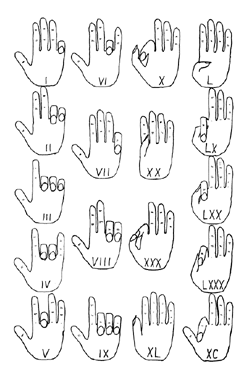
the format is parody, the content is serious
fictis jocari nos meminerit Phaedrus Lib.1
For Latin 'Week' Adam the Adder also wanted to write about how Romans did Maths.
How did the Romans count mentally?
( Finger Counting)
We put this question to the head of Maths, Adam the Adder.
He commences with his usual sibilance, 'I'll sstart by talking about mental arithmetic, then move on to more formal calculationss. Sources on everyday arithmetic are rare. But thanks to incidental references, later commentators and rare archaeological evidence we can make educated guesses.
Finger counting or, dactylonomy, was common, for adults and not just children, as it is now. It is certain that our decimal system evolved from having ten digits. We know it was big in the middle ages, was more prevalent before the advent of the calculator than it is now, so it is hardly surprising the Romans used it. But they didn’t just assign a digit to each digit. That way they would have run out of counters at ten, unless they used other body parts, as some tribes in Papua New Guinea do.
Fig. 1 is from the middle ages, but historians believe it's close to how the Romans did counted.
Finger Counting (fig.1)

You can see that counting one to three is simple, quantitative, like Roman numerals. But then for four the little finger is straight again. This was so the digits 1-9 could be represented with just three fingers of the left hand, leaving the thumb and index finger of that hand available for tens up to ninety, the thumb and index finger of the right hand for 100-900 and the remaining fingers of that hand for numbers from 1,000 to 9,000. By using all these digits 9,999 could be represented. I’d demonstrate myself but, I’m a snake.
How did the Romans learn Maths at School?
There’s a description of a maths lesson in Horace’s ars poetica where the teacher questions his pupils on Maths. Horace is attacking greed in the poem, but it's pretty similar to what may happen in a modern Maths classroom:
Romani pueri longis rationibus assem 323-330
discunt in partis centum diducere. "Dicat
filius Albini: si de quincunce remota est
uncia, quid superat? Poteras dixisse. Triens. Eu!
Rem poteris seruare tuam. Redit uncia, quid fit? "
Roman lads learn long division, and how to split
A pound weight into a hundred parts. ‘Then, tell me
Albinus’ son, if I take an ounce from five-twelfths
Of a pound, what fraction’s left? You should know by now.’
‘A third.’ ‘Good! You’ll look after your wealth.’ Add an ounce,
What then?’ ‘A half.’
If it seems a poor description, it is. There's really little else in the literature. We know of pupils reciting times tables, and we know of written multiplication tables such as in the Calculus of Victorius of Aquitania, which goes up to 50 x 50, so we can imagine educated Romans knew many off by heart. But we have evidence of little else. No number lines, no number grids, no correspondence between teachers describing their methods.
.
What about written methods?
Both at school and at home a Roman would have a tabula (tablet) handy. The much maligned Roman numerals had certain advantages over Arabic numbers. They’re easy to recognise at a glance, and it’s easy to separate tens, hundreds and thousands. Remember, the difference between our system and theirs is that ours has place value and theirs didn't, not that theirs wasn't decimal. It's just a case of rearranging the letters.
The diagram below shows how easy addition could be:
CCCC XX III 423
CC VII + 207
--------------------------------
CCCCCC+XX+V+IIIIII = DCXXX = 630
Even relatively long multiplication can be done with Roman numerals using our common written method, as long as one remembers it's the numbers one is multiplying and not the symbols.
XX III
X II *
--------------
XXXX VI
CC XXX +
---------------
CCLXXVI
OK, what about the abacus?
The best surviving abacus comes from Salamis, a biggie. But the Romans seem to have miniaturised it, and what they came up with is very much like the Japanese Soroban (fig. 3) It’s important to realise how quickly calculations can be done on a modern abacus, often beating electronic calculators. Apparently muscle memory is crucial, and some people are so proficient thy can imagine using one in their head.
The word abacus never actually appears in the literature. The Romans would use calculi (pebbles) or tabula (table), or calculos ponere. The fact that we get the word calculation from calculi shows how widespread it was. Rather than me explaining how they work, for all four operations, I think a link to a soroban simulator would be a good idea: link to soroban simulator .
Talking about calculi, Catullus’ Vivamus Atque Amemus takes on an enhanced significance when you realise that he and his lover are counting their kisses on a calculi.
Da mi basia mille, deinde centum,
Dein mille altera, dein secunda centum,
Deinde usque altera mille, deinde centum.
Dein, cum milia multa fecerimus,
Conturbabimus illa, ne sciamus,
Aut ne quis malus invidere possit,
Cum tantum sciat esse basiorum.
Give me a thousand kisses, then a hundred,
then another thousand, then a second hundred,
then another thousand, then a hundred.
Then, when we have exchanged many thousands,
Let us overturn (the metaphorical abacus), so we forget,
and so no mean spirit will be jealous
to find out how much we have kissed.
It’s quite clear Catullus is talking about counting kisses on the thousands and hundreds column of a calculi. They get to 3,300, MMMCCC, before he loses count. Quite a night.
Modern replica of a Roman Abacus (fig.3)
